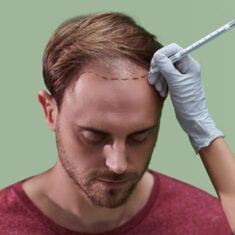In 30 Seconds…
A hair transplant has become a standard treatment for male pattern baldness (MPB). Safe and effective when carried out by a qualified surgeon, it’s the ideal way to restore hair growth and confidence in many men. But what does the process look like? It can take 9-18 months, all in, to see results, and it all starts with a simple consultation. The surgery is usually done and dusted in a day, and you’ve got steps to follow post-op, too.
Many men have turned to hair transplants to treat male pattern baldness. This proven and reliable cosmetic procedure moves hair from one part of the body (known as the “donor site”) to an area on your head that’s thinning or balding (the “recipient site”).
If all goes to plan, the transplanted hair will grow as expected, just like before any hair loss occurred. And with the right level of aftercare and maintenance, you can enjoy a full head of hair once again — and the boost in self-esteem that comes with it.
But what does the hair transplant timeline look like? Let’s explore in more detail.
The Hair Transplant Timeline Uncovered:
Step One: The Consultation
Your first step to getting a hair transplant is a consultation, which involves meeting with the surgeon who will carry out the procedure.
You’ll have a chance to discuss your hair loss and tell them about your medical history, after which they will assess your suitability for a hair transplant and analyse your hair.
Since your hair follicles must be strong and healthy at the time of the transplant, your surgeon may recommend medication to take before the surgery, such as vitamins and supplements and anti-swelling tablets.
Step Two: Before the Procedure
You’ll need to prepare your scalp in the weeks before your procedure.
This involves shaving your hair, and while some people do this gradually in the months before the transplant, others choose to have it done on the day.
Shaving your hair allows your surgeon to replicate the natural direction of the hairs on your scalp, minimising “transection” rates. A transection is the accidental cutting or damaging of the hair bulb (which forms the base of a hair follicle).
In some cases, a hair transplant can be performed if the head is only partially shaven or unshaven. You’ll discuss this with your surgeon during your consultation.
Step Three: Your Hair Transplant Surgery
On the day of your transplant surgery, you should wash your hair and scalp with only shampoo and conditioner, avoiding any other products.
Your surgeon will tell you when you should have your last food or drink before the procedure. Ideally, you should wear loose-fitting clothes, too, as this will help prevent damage to the incision spot when you change after the surgery.
You’ll probably undergo one of two common hair restoration treatments: an FUE or FUT hair transplant. This will usually be carried out under local anaesthetic and sedation. You’ll be awake during the procedure, but you won’t feel any pain. While both approaches will leave you with a small scar on the back of your head, it’s unlikely to be visible.
Here’s a little more about each surgery:
FUT hair transplant
Follicular unit transplantation (FUT) is also known as the strip method. The process involves:
- A very thin strip of skin with hair is removed from the head and then divided into pieces. Each strip has around one to four hairs (hair grafts)
- The grafts are then placed into tiny cuts in the scalp
- The donor site is then closed with stitches
FUE hair transplant
A follicular unit extraction (FUE) is widely seen as the gold standard when it comes to hair transplants. The process involves:
- The back of the head being shaved
- Individual hairs being removed one by one (grafts)
- The grafts being placed into small cuts in the scalp
Step Four: Post-Op Recovery
The recovery period is key to ensuring your hair transplant is a success.
Most people can return to work a few days after a hair transplant. However, you’ll need to be careful with your newly restored head of hair for at least two weeks after the surgery — the grafts won’t be fully secure during this time. Your surgeon may even advise that you cut down on exercise for the first month to help reduce the risk of scarring.
Hands off!
While you can take your bandages off after two to five days, you shouldn’t touch the grafts.
By day six, you should be able to wash your hair. However, you must do this gently, by hand, so as not to aggravate any scabs.
After two weeks, stitches can often be removed. New hair will begin to appear after six months, but you may need to wait up to 18 months to see the full results of the surgery.
Step Five: Maintenance
With the latest hair transplant procedures, a hair transplant is now widely considered a permanent procedure that requires next-to-no follow-up visits. And in 9 to 18 months, you should see the positive results of your surgery.
However, although the newly transplanted follicles will continue to grow for many years, it’s essential to recognise that it may not cure your hair loss. After decades, your hairline might not look as healthy as in the first years of your hair transplant. For this reason, some people opt to have a second hair transplant surgery (known as “revision surgery”) to replenish their thinning hair.
Meanwhile, you may be encouraged to maintain your new locks with Minoxidil and Finasteride, two of the most effective hair loss treatments on the market today.
Read more: How Long Does a Hair Transplant Last?
Key Takeaways
A hair transplant is a great way to prevent male pattern baldness, giving you a full head of hair and improving your confidence and self-esteem. For the best results, choose a fully qualified surgeon experienced in performing this surgery. Manual can help you do this.
Take that first step on your hair growth journey by answering a few quick questions here. We can then pair you with the right clinic for your situation.
FAQs
What is the timeline of a hair transplant?
The hair transplant timeline is around 9-18 months.
- A hair transplant can take months, even up to a year or more, to show results. At least a week pre-surgery, you’ll need to cut out caffeine, alcohol, spicy food, supplements, and more.
- The surgery itself can usually be done in a day, although depending on your situation, you may need to return the next day or a few days later to finish it.
- In the weeks following the procedure, the grafts start to take hold. And by the 6-month mark, you should be at a stage where you’re happy with the results.
What happens after 4 months of hair transplant?
As a rule of thumb, 4 months after your hair transplant, 40% of the hair should have penetrated the scalp. This rises to 50% by the end of month five and 60% to 70% by month six. By the ninth month following the surgery, you should be able to see 90% to 100% of transplanted hairs.
How long does it take before you see the full results?
New hair can appear around 6 months after hair transplant surgery. However, you may need to wait up to 18 months to see the full results of your surgery.









